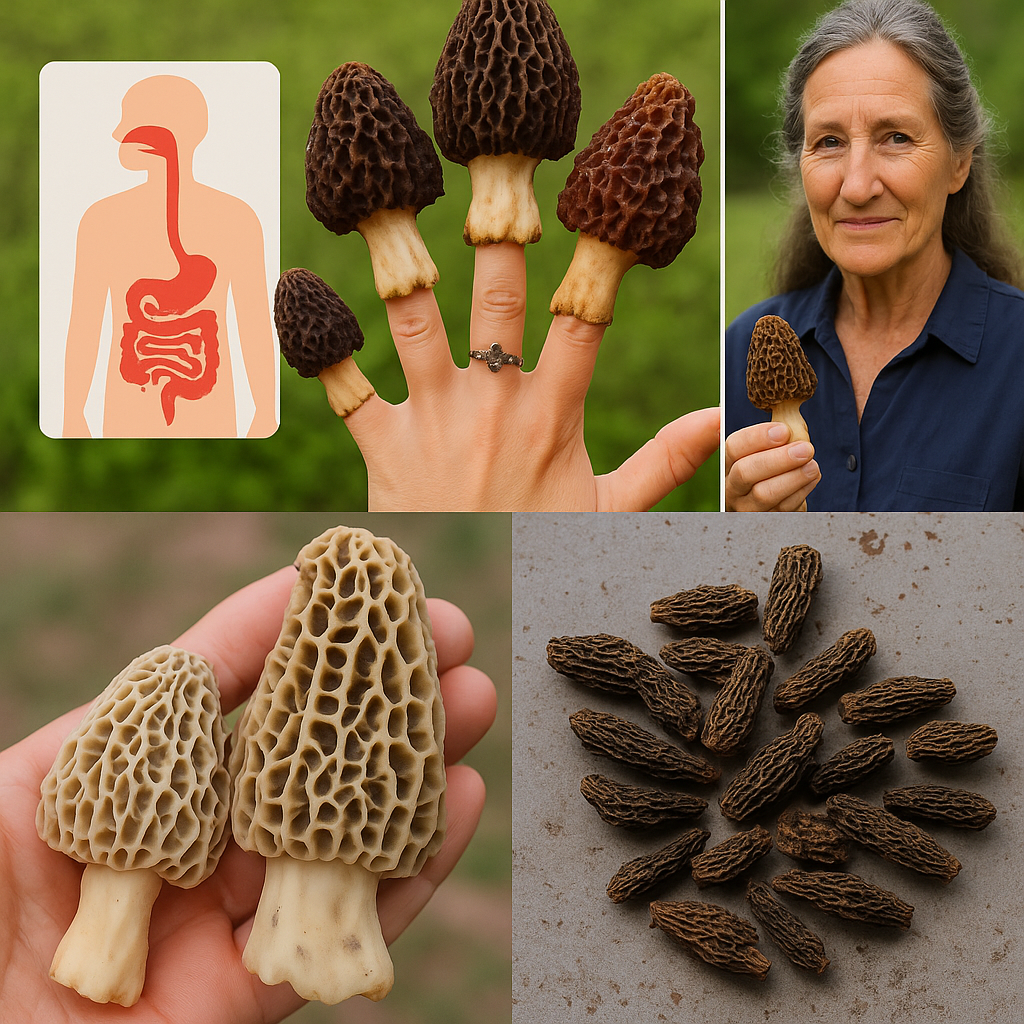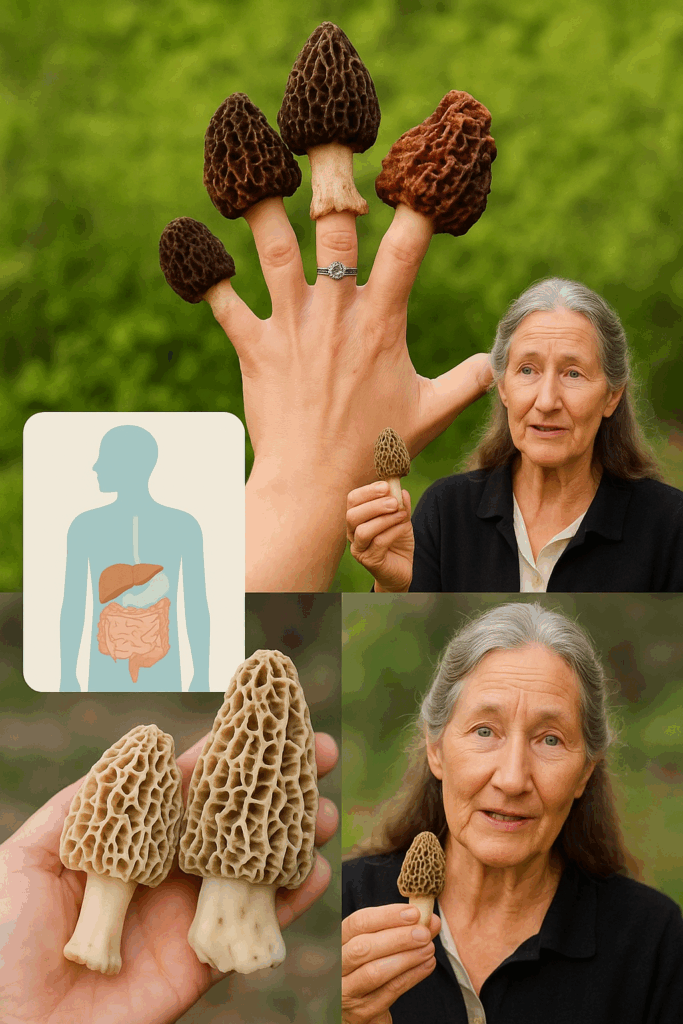Few wild foods evoke as much excitement as the elusive Morel mushroom. With their spongy, honeycomb-like caps and deeply earthy flavor, Morels (Morchella spp.) have earned their place as one of the most sought-after edible fungi by gourmet chefs, foragers, and health-conscious foodies alike.
But beyond their culinary appeal lies an impressive range of nutritional and health benefits—along with crucial safety considerations that every consumer should understand.
Let’s take a closer look at the most popular types of Morel mushrooms, the science-backed reasons to add them to your diet, and the safest ways to enjoy them.

🍽️ Popular Types of Morel Mushrooms
1. Yellow Morel (Morchella esculenta)
The most recognized and widely collected variety, often found near elm, ash, and oak trees. Its yellow-tan cap and hollow stem make it a favorite in springtime foraging.
2. Black Morel (Morchella elata)
Darker in color with more pronounced ridges, this type typically appears in cooler climates, especially in forests affected by burns or logging.
3. Half-Free Morel (Morchella punctipes)
Smaller and distinguished by a cap that is partially attached to the stem, this species is commonly found in wooded areas across North America.
4. Burn-Site Morel
This variety thrives in recently disturbed or fire-affected soil, often appearing in large quantities the season after a wildfire.
💪 Health Benefits of Morel Mushrooms
Packed with Nutrients
Morels are nutrient-dense, offering vitamin D, various B-complex vitamins, iron, copper, manganese, and potassium—all of which support bodily functions from energy production to nerve health.
Immune-Boosting Properties
Morels contain powerful antioxidants such as selenium and polysaccharides that help fortify the immune system and protect against free radical damage.
Supports Bone Health
With high levels of natural vitamin D, Morels enhance calcium absorption, making them supportive of strong bones and teeth—especially valuable for those with limited sun exposure.
Promotes Digestive Health
Dietary fiber in Morels contributes to a balanced gut microbiome and smoother digestion, reducing the risk of constipation and bloating.
Skin and Cellular Health
Antioxidants in Morel mushrooms help reduce oxidative stress, which may aid in maintaining youthful skin and cellular repair.
Helps Manage Weight
Morels are naturally low in fat and calories, while still being high in protein and fiber—ideal for those looking to stay full and energized without overindulging.
Anti-Inflammatory Benefits
Natural compounds in Morels may help reduce inflammation, supporting joint health and reducing the risk of chronic conditions linked to systemic inflammation.
Supports Cardiovascular Health
Morels may aid in lowering LDL (bad) cholesterol levels and improving circulation, contributing to a healthier heart.
Boosts Energy Metabolism
Rich in B vitamins such as riboflavin, niacin, and pantothenic acid, Morels help convert food into usable energy efficiently.
Potential Anticancer Support
Emerging research suggests that certain compounds in Morels could possess anti-tumor properties, although more human studies are needed to confirm their effects.

⚠️ Safe Usage: How to Enjoy Morels Without Risk
Always Cook Thoroughly
Never eat Morel mushrooms raw. They contain hydrazine-like compounds that are potentially toxic unless fully cooked. Sautéing, frying, or simmering for at least 15–20 minutes neutralizes these compounds and brings out their rich flavor.
Clean Gently and Thoroughly
Use a soft brush or rinse quickly under cold water to remove dirt and insects. Avoid soaking as Morels are porous and can become waterlogged, losing flavor and texture.
Avoid Toxic Look-Alikes
Be vigilant for false morels (Gyromitra spp.), which can be dangerous or even fatal. True Morels are completely hollow inside, whereas false morels often have chambered or solid stems and irregular caps. If unsure, consult an expert or use a reliable mushroom identification guide.
Consume in Moderation
Even when properly prepared, large servings of Morels may cause digestive upset in sensitive individuals. Start with small amounts to see how your body reacts.
Refrigeration and Storage
Fresh Morels should be stored in a paper bag in the refrigerator and consumed within 2–3 days. You can also dry them for long-term storage—simply slice, dehydrate, and store in an airtight container. Rehydrate before use in soups, stews, or sauces.
Watch for Allergies
Introduce Morels gradually if you’ve never eaten them before. Though rare, some people may experience allergic reactions.
👨🍳 How to Enjoy Morels in the Kitchen
Morels are a gourmet’s dream—meaty, aromatic, and intensely savory. They pair beautifully with butter, garlic, cream sauces, and spring vegetables like asparagus and peas. Try them:
- Sautéed with shallots and white wine
- Stuffed with herbs and cheese
- Stirred into risottos or pasta
- Mixed into savory omelets
- Folded into creamy soups and sauces
Tip: Always slice Morels lengthwise to check for bugs or grit inside their hollow caps before cooking.
🌿 Final Thoughts: A Seasonal Treasure Worth Savoring
Morel mushrooms offer a rare blend of culinary excellence and health benefits. But with that value comes responsibility—respect the risks, follow proper preparation guidelines, and when foraging, only collect mushrooms you can identify with absolute confidence.
Enjoying Morels safely and knowledgeably can elevate your meals, support your wellness goals, and connect you more deeply to the natural world. Whether you buy them at a specialty market or find them on a forest walk, Morels remain a wild delicacy that both nourishes and delights.
Disclaimer: This article is for informational purposes only. Always consult a qualified expert before consuming wild mushrooms.


